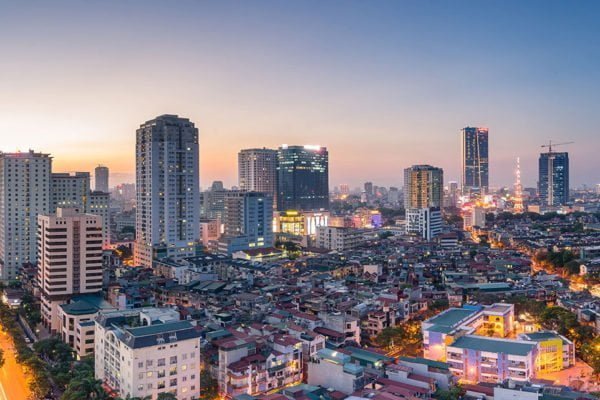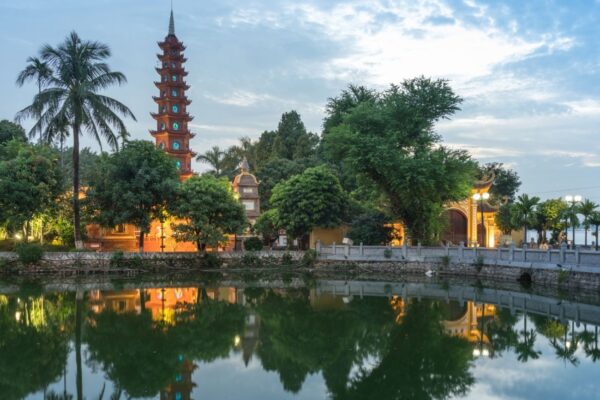Visiting the Imperial Citadel of Thang Long: What You Need to Know

Tucked away in the heart of Hanoi, the Imperial Citadel of Thang Long stands as a testament to Vietnam’s rich heritage. For over 13 centuries, it has been the country’s political hub, witnessing the rise and fall of many dynasties.
Today, this UNESCO World Heritage Site attracts visitors with its captivating history and stunning architecture. Amidst the hustle and bustle of Hanoi, the citadel offers a serene escape into the past.
Curious about what makes this ancient site so special? Join us as we explore the architectural and cultural wonders of the Imperial Citadel of Thang Long!
A Glimpse Into History Of The Imperial Citadel Of Thang Long
In the 11th century, the Ly Dynasty built the Imperial Citadel of Thang Long, marking Dai Viet’s rise to independence. The citadel was constructed on the foundation of a Chinese fortress in the 7th century, and for nearly 1,300 years, it served as a key political center.
In 2009, the Imperial Citadel of Thang Long was recognized as one of Vietnam’s ten special national heritage sites. It was also added to the UNESCO World Heritage List in 2010 due to its historical significance, long-standing role in governance, and rich cultural layers.
The citadel’s history reflects the rule of various dynasties, starting from Dai La, the capital of An Nam, under the Chinese Tang Dynasty in the 7th to 9th centuries. It later became the Forbidden City of Thang Long under the Ly, Tran, Early Le, Mac, and Late Le dynasties, and finally, Thang Long – Hanoi in the 19th century under the Nguyen Dynasty. Its historical importance continued through the French colonial period and into modern times.
Culturally, the artifacts found at the site reveal a long history of cultural exchange. The architecture, palace layout, and decorations show influences from China, Champa, and France, reflecting the diverse cultural developments throughout history.
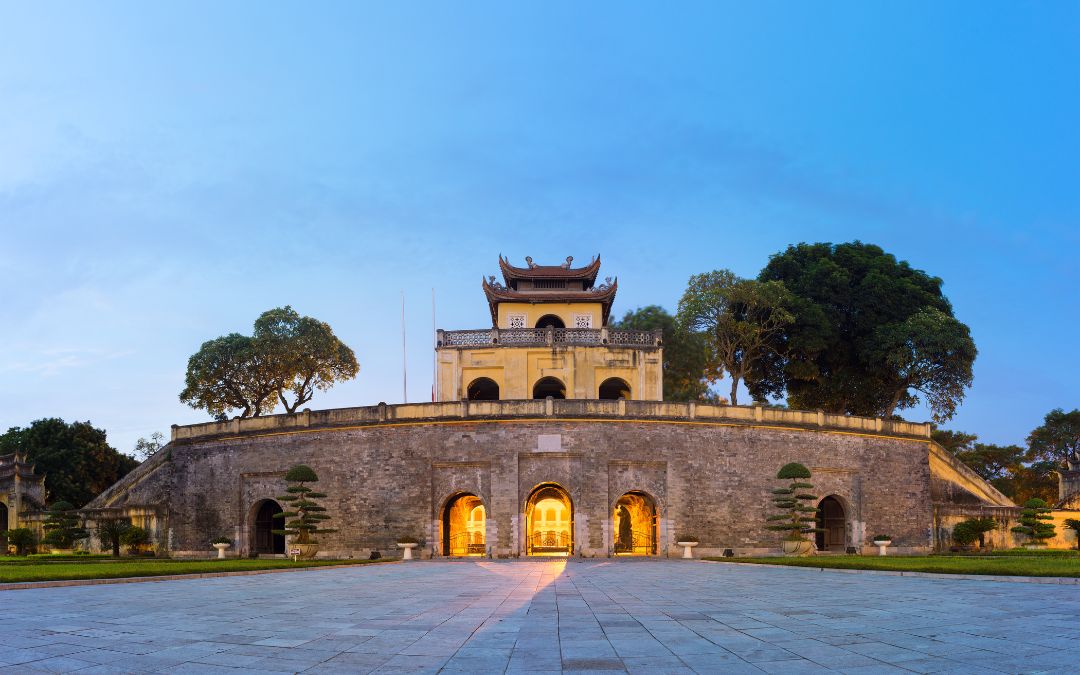
The Imperial Citadel of Thang Long has a rich history dating back over 1,000 years.
>> Discover more: Explore 14 Vietnam Historical Landmarks
Wonders Inside The Imperial Citadel of Thang Long
The ancient walls and stunning structures of the Imperial Citadel of Thang Long are a remarkable testament to history and culture. They undeniably showcase Vietnam’s rich heritage. Every corner, from the grand gates to the serene gardens, speaks volumes of the captivating stories that define this iconic site.
Main Attractions
The Main Gate (Doan Mon)
Doan Mon serves as the primary entrance to the Imperial Citadel of Thang Long, situated to the south of Kinh Thien Palace. Built in a U-shape, it features five gates symmetrically aligned along a central axis, known as the “righteousness axis.” The gate showcases an elegant design with three rolling arches, which not only enhances its beauty but also provides excellent load-bearing capacity.
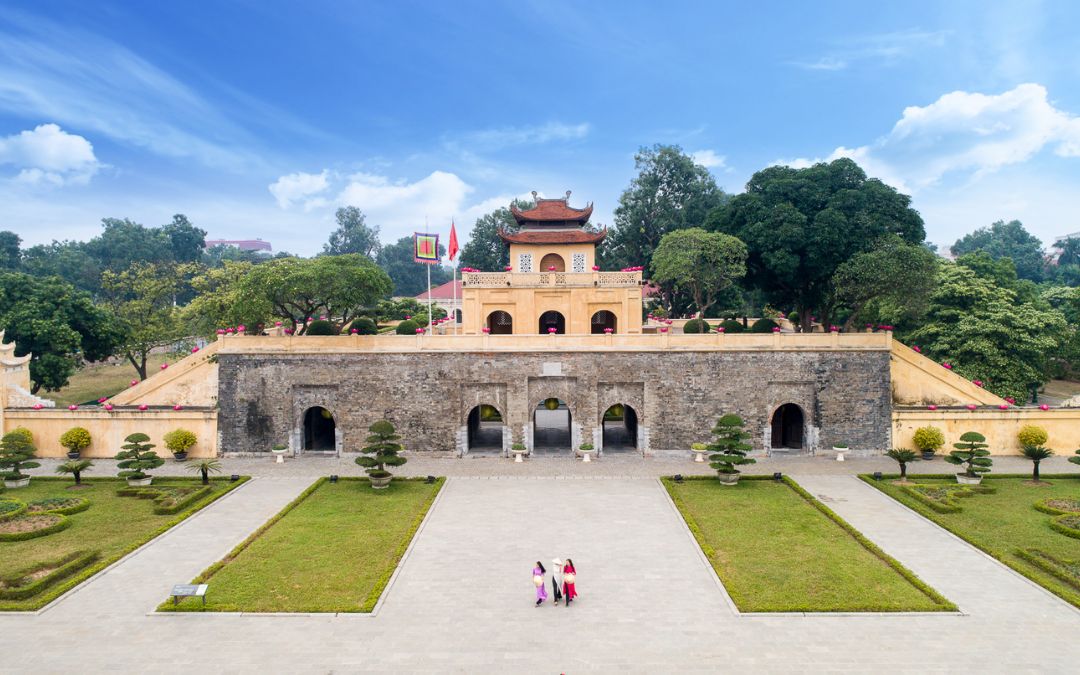
The Doan Mon Gate serves as the main entrance to the Imperial Citadel of Thang Long
Constructed primarily from wooden hammer bricks and stones, Doan Mon measures 47.5 meters from east to west and 13 meters from south to north. The main central door, 4 meters high and 2.7 meters wide, was exclusively for the King. Flanking doors for other dignitaries are smaller, measuring 3.8 meters high and 2.5 meters wide. Above the main entrance, the words “Doan Mon” are carved on a stone plaque, marking its historical significance as a royal entrance.
Northern Gate (Cua Bac)
Chinh Bac Mon, or Cua Bac, is located on Phan Dinh Phung Street and is the last remaining gate of the Hanoi Citadel from the Nguyen Dynasty. It was reconstructed in 1805, preserving the foundation of the earlier Le Dynasty’s Northern Gate. The architectural design includes a watchtower gazebo that allowed imperial troops to observe the surroundings and interior of the citadel.
The North Gate stands as a testament to the valiant efforts of soldiers and citizens during the resistance against French colonial forces. This gate measures 8.71 meters in height and 17.08 meters in width, with four doors providing access in all directions. Partial restorations aim to honor the memories of heroes such as Nguyen Tri Phuong and Hoang Dieu, who valiantly defended the citadel during the late 19th century. Bullet holes from French cannon fire remain visible, serving as reminders of this tumultuous period.
Hanoi Flag Tower
The Hanoi Flag Tower, situated on Dien Bien Phu Street, was built in 1812 during the Nguyen Dynasty. It is one of the few architectural structures in Hanoi that survived the destructive impacts of French colonial rule from 1894 to 1897. On October 10, 1954, the national flag of Vietnam was hoisted here for the first time, symbolizing the liberation of Hanoi.

The Hanoi Flag Tower is a prominent symbol of the city within the Imperial Citadel
The tower has since become an iconic symbol of the city and a significant historical monument recognized in 1989. It features a three-tiered base topped by a three-story tower, constructed in a truncated square pyramid style with brick facades. The Flag Tower not only marks the historical significance of the site but also serves as a proud emblem of Vietnam’s independence.
Kinh Thien Palace
Kinh Thien Palace, the heart of the Imperial Citadel, was originally constructed in the 15th century during the Le Dynasty. This palace served as the venue for royal ceremonies, significant state affairs, and receptions for foreign dignitaries. The remnants of its foundation and threshold provide insights into the palace’s former grandeur.

Kinh Thien Palace was once the central structure of royal power in the Thang Long Citadel
The site is crucial, as it symbolizes the dual historical importance of Kinh Thien Palace in ancient times and its role as the Headquarters of the General Commander of the Vietnam People’s Army in modern history. The foundation measures 57 meters in length and 41.5 meters in width, showcasing a granite staircase and dragon carvings from the 15th century. Though only fragments of the original architecture remain, they echo the palace’s historical and cultural significance.
Lady Pavilion (Hau Lau)
Hau Lau, also known as the Lady Pavilion, spans approximately 2,392 square meters. Built after the Later Le dynasty, it served as the residence for queens and princesses. The pavilion features traditional Vietnamese architecture with multi-level roofs adorned with crescent-shaped blades.

The Lady Pavilion, or Hau Lau, served as a place of residence for royal women
In the late 19th century, Hau Lau was severely damaged but was later restored by the French, resulting in its current appearance. Visitors to Hau Lau can gain insight into the lives of royal women in Vietnam’s history. The pavilion’s blend of historical significance and architectural beauty makes it a fascinating stop for those exploring the Imperial Citadel.
D67 Revolutionary House
D67 Revolutionary House is a significant structure within the Imperial Citadel, built in 1967 during the Second Indochina War. This house served as the military headquarters for the Vietnam People’s Army, where critical strategies against U.S. forces were developed. The design incorporates thick walls for sound insulation and bomb protection, reflecting its military purpose.

The D67 Revolutionary House played a significant role during the Vietnam War as a military headquarters
Inside, it features a meeting room for the Politburo and working areas for key military leaders like General Vo Nguyen Giap. Although unassuming from the outside, the house remains one of the few intact military structures from that era, preserving the heritage of Vietnam’s resistance against foreign aggression.
Exhibitions and Artifacts
The Imperial Citadel of Thang Long features exhibitions and artifacts showcasing Vietnam’s rich history. Visitors can explore archaeological finds like pottery, coins, and tools from various dynasties, offering insights into daily life. The exhibits also highlight the citadel’s significance in national defense and governance, making it a must-visit for history enthusiasts.
Archaeological Site at 18 Hoang Dieu
The archaeological site at 18 Hoàng Diệu Street is the largest excavation ever conducted in Vietnam. It has unveiled thousands of fascinating relics dating back to the 7th century. Covering an area of 45,000 square meters, this site is a treasure trove for history enthusiasts. Notable discoveries include:
- Stone Pillars: These monumental structures hint at the architectural sophistication of ancient civilizations.
- Ancient Wells: Providing insights into the daily lives of people from centuries ago.
- Roof Ornaments: Decorative elements that showcase the artistry of different dynasties.
- Tiles: Beautifully crafted tiles that illustrate the building techniques used during various periods.
- Pottery: Diverse pottery pieces that reveal information about trade and culture.
Visitors can enjoy shaded walkways that guide them through this historical landscape, allowing them to admire the invaluable artifacts. During the summer months, a nearby lotus pond offers a peaceful spot to relax and take photos of the vibrant blooming flowers.

The archaeological site at 18 Hoang Dieu reveals valuable insights into ancient Thang Long
This site has revealed artifacts spanning over 1,300 years, showcasing a rich tapestry of history from several dynasties:
- Dai La Dynasty (7th–9th centuries)
- Dinh and Early Le Dynasties (10th century)
- Ly Dynasty (1009–1225)
- Tran Dynasty (1226–1400)
- Ho Dynasty (1400–1407)
- Primal Le Dynasty (1428–1527)
- Mac Dynasty (1527–1592)
- Revival Le Dynasty (1592–1789)
- Nguyen Dynasty (1802–1945)
These findings illustrate the continuous historical layers present in the Thang Long area, which few capital cities worldwide can boast.
The site consists of three floors and is divided into four zones (A, B, C, and D) by the Archaeological Institute:
- Zone A: The lower floor, which is part of the Dai La citadel from the Cao Bien period during the Tang Dynasty.
- Zone B: The upper floor features the palaces of the Ly and Tran dynasties, along with a central part of the Le dynasty.
- Zone C: This area represents the heart of the Hanoi citadel in the 19th century.
Large-scale excavations conducted between 2002 and 2003 revealed numerous architectural structures that have developed over 1,300 years, even though only 6% of the area has been excavated. This ongoing uncovering of relics highlights the continuous historical significance of Thang Long.
Note: After exploring the site, visitors can unwind at Civie Coffee, an outdoor café serving delightful Vietnamese coffee under ancient trees, making it a perfect spot for a relaxing break.
Art and Ceramic Exhibits
Your ticket to the Imperial Citadel of Thang Long opens the door to fascinating art exhibits located in historic buildings just beyond the main gate.
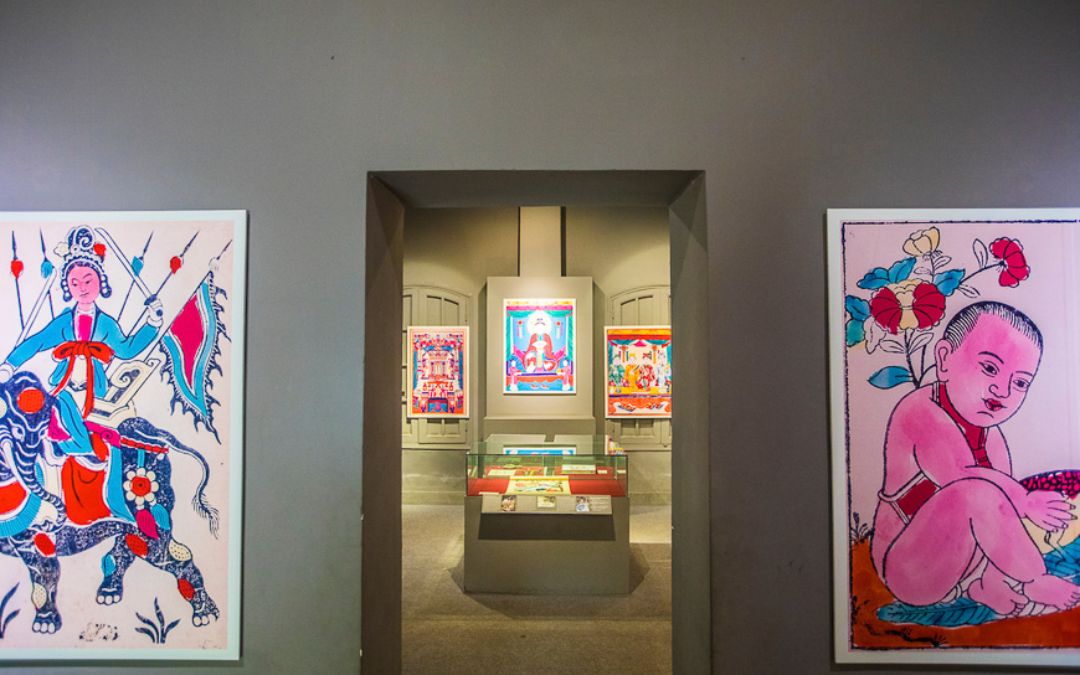
Art and ceramic exhibits in the Citadel showcase Vietnamese craftsmanship and culture
One highlight is a collection of 50 Vietnamese folk paintings showcasing various styles from across the country. These artworks are based on the book “Vietnamese Folk Paintings,” authored by French linguist Maurice Durand, which is preserved at the French Academy of the Far East (EFEO). Visitors can also participate in a two-day exhibition where they can learn how to create their own folk paintings, adding a hands-on experience to their visit.
Another captivating exhibit showcases terracotta and clay artifacts discovered during excavations at the site. This display features a chronological arrangement of these items, providing insight into the historical context of the Thang Long Imperial Palace. The site has revealed millions of archaeological artifacts, including utensils and tools that were used in royal life. Among these discoveries, the finest ceramics from the Le Dynasty stand out, offering a glimpse into the artistry of that era.
A significant discovery is a collection of precious metalware and high-quality pottery from the Thang Long Imperial kiln, made for the royal family. Among these is a delicate white porcelain bowl decorated with a dragon and the Guan character, recognized as a national treasure. This bowl highlights the exceptional craftsmanship and technological prowess of the artisans during the later Le dynasty, reflecting Vietnam’s rich artistic heritage in porcelain production.
Make sure to take your time exploring these remarkable artworks and artifacts, as they represent a unique connection to Vietnam’s past and cultural identity.
Distinctive Tours
The Imperial Citadel of Thang Long attracts numerous tourists each year, prompting a variety of tours for both locals and foreigners. These tours offer deep insights into the site’s history and provide engaging cultural experiences that enrich visitors’ understanding.
- Night tours: One unique option is the night tour of the Imperial Citadel of Thang Long. Participants can explore the citadel illuminated by night, which adds a magical touch to the experience. During the tour, you can join an ancestral incense ceremony at Kinh Thien Palace and take part in the Imperial Citadel Decoding game, which features meaningful prizes.
- Tours for foreign visitors: Special tours are tailored for foreign tourists, allowing them to dress in royal costumes for photo opportunities. Guests can listen to captivating historical stories about various relics, enjoy folk art performances, and immerse themselves in local culture at the souvenir stalls.
- Tours for domestic visitors: Domestic tours are similar, but they include additional activities such as participating in an incense offering ceremony at Kinh Thien Palace. Visitors also have the chance to release birds, symbolizing peace and tranquility.
Special Events
The Thang Long – Hanoi Heritage Conservation Center plays a vital role in enhancing the experience at the Imperial Citadel by organizing cultural events and annual festivals. Key celebrations include:
- Lunar New Year Celebration: This festival marks one of the most significant holidays in Vietnam. Visitors can partake in traditional activities such as lion dances, folk games, and food stalls featuring seasonal delicacies. The atmosphere is filled with vibrant decorations and cultural performances, offering a glimpse into Vietnamese traditions.
- Mid-Autumn Festival: The Mid-Autumn Festival, known for its lantern displays and mooncake offerings, attracts many families to the citadel. The festival includes storytelling sessions about the legends associated with the moon, traditional music performances, and activities for children, creating a joyful and festive environment.
- Hanoi Craft Village Tourism Festival: This festival celebrates the rich heritage of Vietnamese craftsmanship. Artisans from various craft villages showcase their skills in pottery, weaving, and wood carving. Visitors can participate in hands-on workshops, learn about the crafting process, and purchase unique handmade souvenirs.
- Hanoi Ao Dai Festival: Celebrating the traditional Vietnamese dress, the Ao Dai Festival features fashion shows, cultural performances, and exhibitions that highlight the beauty and history of the Ao Dai. Visitors can admire colorful displays and even try on these elegant outfits for memorable photos.
- Hanoi Book Fair: This event promotes literature and reading culture. The book fair offers a wide range of books, author signings, and literary discussions. Visitors can explore stalls featuring both local and international authors while enjoying workshops and storytelling sessions.

Special events at the Imperial Citadel of Thang Long often include cultural performances and celebrations.
Practical Information For Visitors
How To Reach The Imperial Citadel of Thang Long
The Imperial Citadel of Thang Long is located at 19C Hoang Dieu Street, in the heart of Hanoi, approximately 2 kilometers from the Old Quarter. Here are some convenient ways to reach the site:
- Taxi or motorbike service: You can easily book a tech-based taxi or motorbike service for a hassle-free journey.
- Public Bus: Take Bus Route 22. This route stops directly in front of the main gate at 19C Hoang Dieu Street. It’s an affordable option for travelers.
- Driving directions: You can also hire a motorbike and navigate your way to the citadel yourself. If you’re traveling by car or motorbike from Hoan Kiem Lake, head towards Trang Thi Street. Turn onto Dien Bien Phu Street and then onto Hoang Dieu Street. Continue until you reach 19C, the Central Relic Area of the Imperial Citadel. You can use Google Maps for navigation.
Once you arrive, you can also explore nearby attractions like Cua Bac Church, Quan Thanh Temple, and the Vietnam Military History Museum by taking a short walk from the citadel.
Opening Hours and Ticket Price
Operating hours: Every day from 8:00 to 17:00.
Visitors to the Imperial Citadel of Thang Long can purchase standard tickets at the following prices:
- Adults: 70,000 VND ($3)
- Students aged 16 and older (with a student ID) and senior citizens (60 years and older) who are Vietnamese citizens (must present an ID or any document proving senior status): 35,000 VND ($1.5)
- Children under 16: Free admission
To book tickets online for the Imperial Citadel of Thang Long, follow these simple steps:
- Visit the booking website: http://vedientu.hoangthanhthanglong.com/en/node/add/book-ticket
- Fill out the required information on the form.
- Complete your ticket payment.
Best Times to Visit
Visiting the Imperial Citadel of Thang Long is possible year-round, but the best times are during spring (February to April) and autumn (September to November).
- Spring: The weather is mild, with temperatures averaging around 20°C (68°F). This season offers blooming flowers and vibrant greenery, making your visit more enjoyable.
- Autumn: This period features cool, refreshing air with temperatures ranging from 18°C to 25°C (64°F to 77°F). The skies are often clear, perfect for sightseeing and outdoor activities.
Both seasons avoid the summer heat and heavy rains, providing a pleasant environment for exploring the citadel and engaging in various activities in Hanoi. Additionally, visiting during these times often means fewer crowds, allowing for a more intimate experience with the site’s rich history.
Nearby Attractions
The Imperial Citadel of Thang Long is surrounded by several captivating attractions that enhance your visit to Hanoi. Here are some noteworthy nearby sites:
Ho Chi Minh Mausoleum
Located just a short walk from the citadel, the Ho Chi Minh Mausoleum is a must-visit. This iconic structure houses the embalmed body of Vietnam’s founding father, Ho Chi Minh. The site also includes the Ho Chi Minh Museum and the surrounding gardens, where visitors can learn about his life and contributions to the country.
One Pillar Pagoda
Near the mausoleum, the One Pillar Pagoda is a historic Buddhist temple built in 1049. Its unique design features a wooden structure perched on a single stone pillar, resembling a lotus flower. The pagoda is not only a significant spiritual site but also an architectural marvel that attracts many tourists.
Vietnam Military History Museum
Located within a 15-minute walk from the citadel, this museum showcases Vietnam’s military history. Exhibits include artifacts, photographs, and vehicles from various conflicts, including the Vietnam War. The museum provides a deeper understanding of the country’s resilience and spirit.

Nearby attractions like the Ho Chi Minh Mausoleum and the Vietnam Military History Museum complement a visit to the Citadel.
Temple of Literature
Located about 1.5 kilometers from the citadel, the Temple of Literature is Vietnam’s first national university, established in 1070. This beautiful complex is dedicated to Confucius and honors Vietnam’s scholars. Visitors can explore stunning architecture, tranquil gardens, and numerous stone tablets inscribed with the names of graduates, making it a significant cultural and educational site.
Thang Long Water Puppet Theatre
Just a short distance from the citadel, this theater offers a unique cultural experience. Water puppetry is a traditional Vietnamese art form that dates back centuries. Enjoy a lively performance showcasing folklore and local stories, all performed on water.
West Lake
A bit further from the citadel, West Lake is the largest lake in Hanoi, offering a peaceful escape from the bustling city. Visitors can enjoy walking, cycling, or dining along the waterfront. The lake area is known for its beautiful sunsets and vibrant atmosphere.

A tour around the Imperial Citadel of Thang Long offers a deep dive into Vietnam’s royal history.
>> You might want to know: How To Make The Most Out Of One Week In Hanoi?
What You Can Expect From a Tour Around the Imperial Citadel of Thang Long
Visiting the Imperial Citadel of Thang Long offers a rich blend of history, culture, and interactive experiences for all ages. Here’s what you can expect during your tour:
Interactive Tours for Families
Family-friendly tours at the citadel provide a fun and educational experience for children. These tours often include guided storytelling and hands-on exhibits that engage young visitors with Vietnam’s history. One of the highlights is the “Decoding the Thang Long Imperial Citadel” night tour, lasting about 90 minutes.

Interactive tours designed for families make the Imperial Citadel an engaging experience for all ages
Tour Highlights:
- Start at Doan Mon: Experience royal court dances, setting a captivating tone for the evening.
- Exhibition Hall: Admire valuable artifacts discovered at the citadel.
- Kinh Thien Palace: Pay homage to past emperors in this significant area.
- Archaeological Site at 18 Hoang Dieu: Explore the rich history uncovered at this site.
- Interactive Game: Conclude with a fun game where visitors can decode projected artifacts with laser technology, revealing fascinating details and hints.
After the tour, relax under the ancient Bodhi tree while enjoying lotus tea and candied lotus, creating a memorable end to your visit.
Cultural Events and Festivals
The Imperial Citadel also hosts various cultural events and festivals throughout the year. Celebrations during Tet (Vietnamese Lunar New Year) are particularly vibrant, featuring traditional performances, food stalls, and local crafts. These events offer a unique opportunity to experience Vietnamese culture and traditions firsthand.
Photography and Souvenir Tips
For photography enthusiasts, the citadel provides numerous picturesque spots. Here are some tips to capture the best moments:
- Look for elevated positions or corners to get expansive shots of the architecture.
- Visit early in the morning or late in the afternoon for the best natural lighting.
- Adhere to site regulations, such as avoiding the use of drones and obtaining permission for filming. Dress neatly and respectfully, keeping the environment clean and quiet.
- Avoid writing or drawing on walls, breaking branches, or picking fruits. Additionally, do not bring flammable or harmful substances onto the site.

Photography enthusiasts will find plenty of picturesque spots, and souvenir shops offer unique keepsakes from the citadel
When it comes to souvenirs, nearby markets like Dong Xuan Market or Old Quarter offer a variety of local crafts, artwork, and traditional snacks. Be sure to explore these markets for unique finds to take home.
Let’s wrap up the information in this video:
Step Back in Time with Asia Pioneer Travel
The Imperial Citadel of Thang Long is not just a historical site; it’s a gateway to Vietnam’s rich cultural heritage. Whether you’re exploring its ancient architecture or engaging in interactive tours, this remarkable landmark offers something for everyone.
Step back in time with Asia Pioneer Travel and discover the wonders of the Imperial Citadel of Thang Long. Book your unforgettable journey today!



